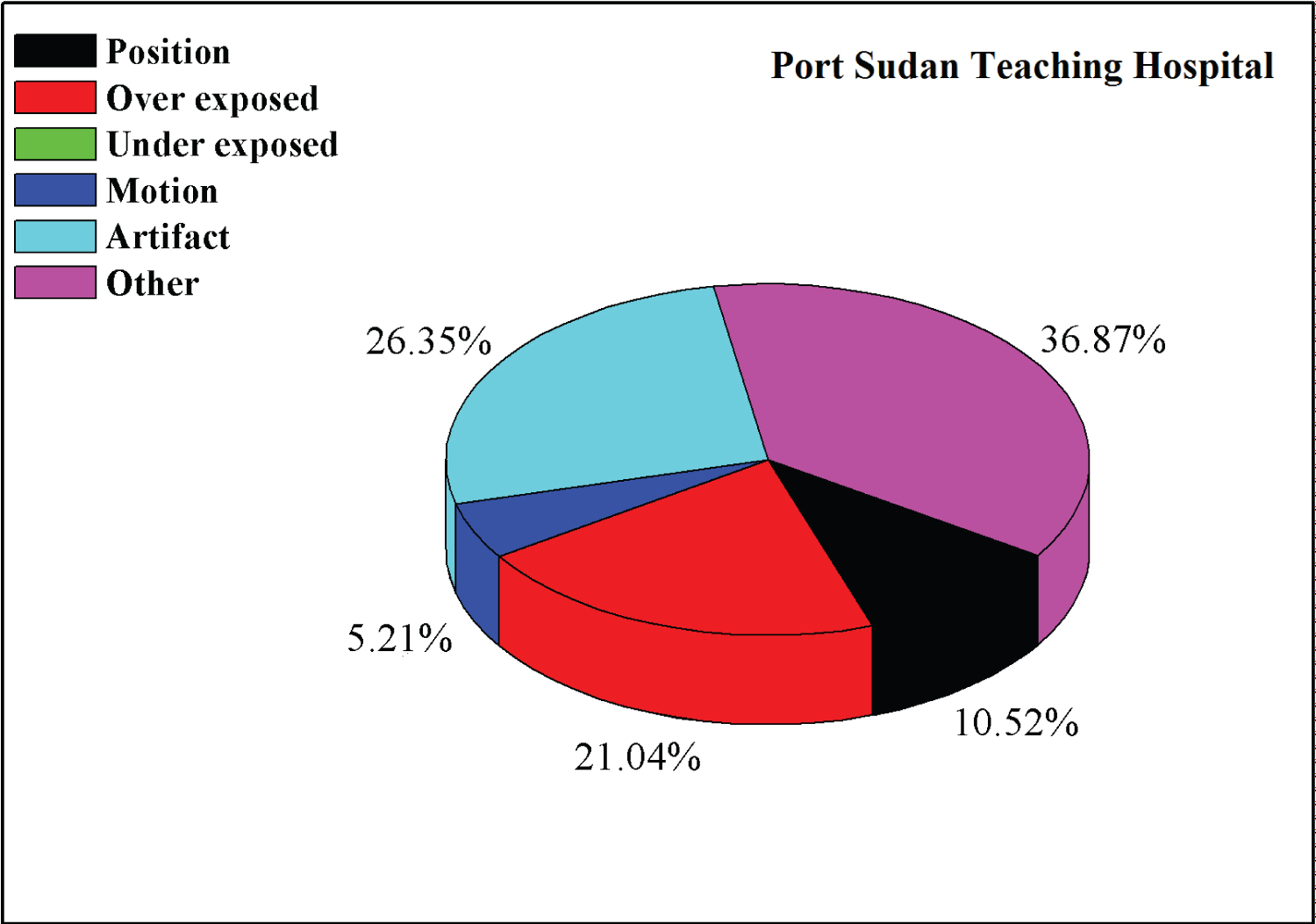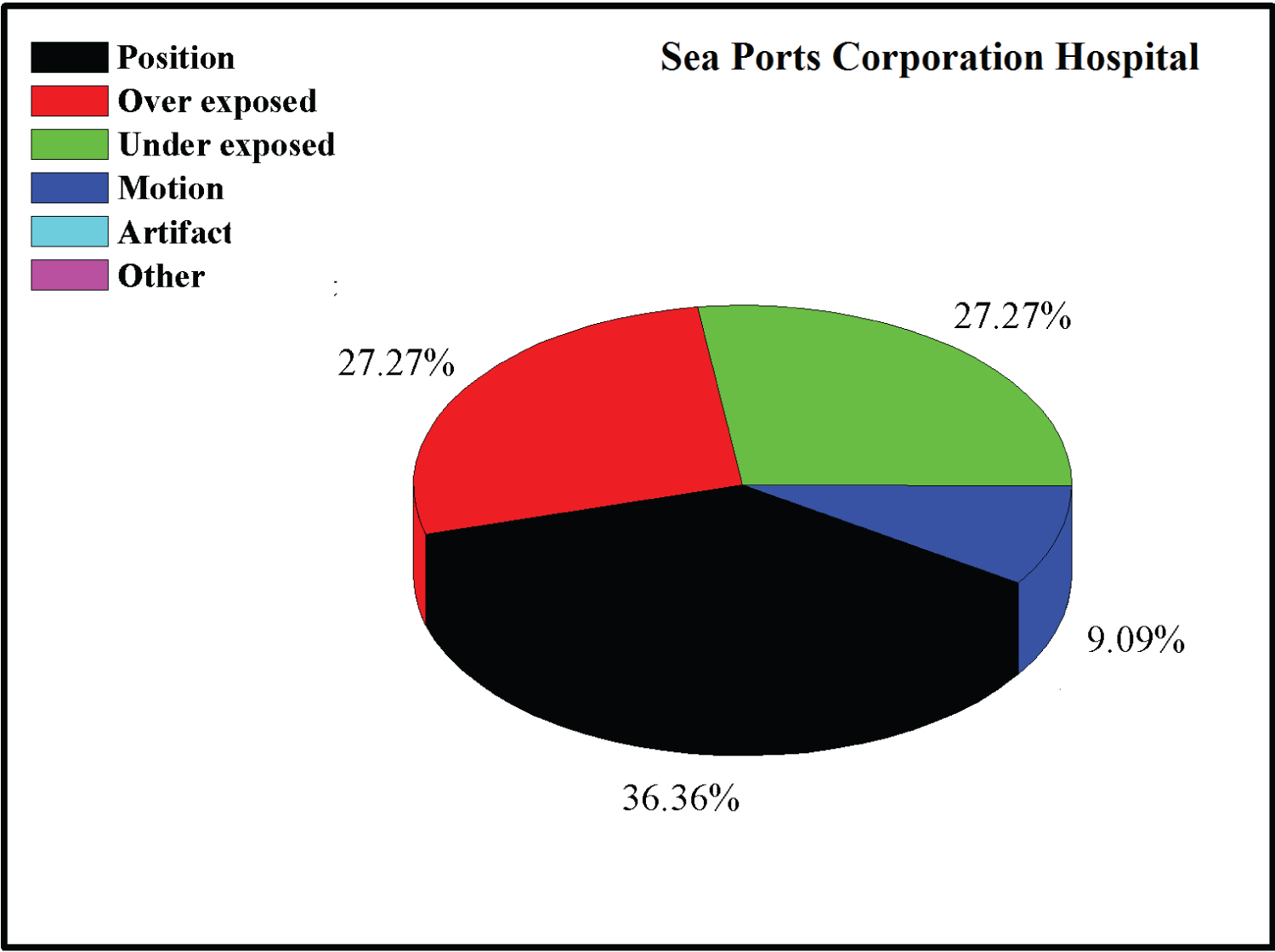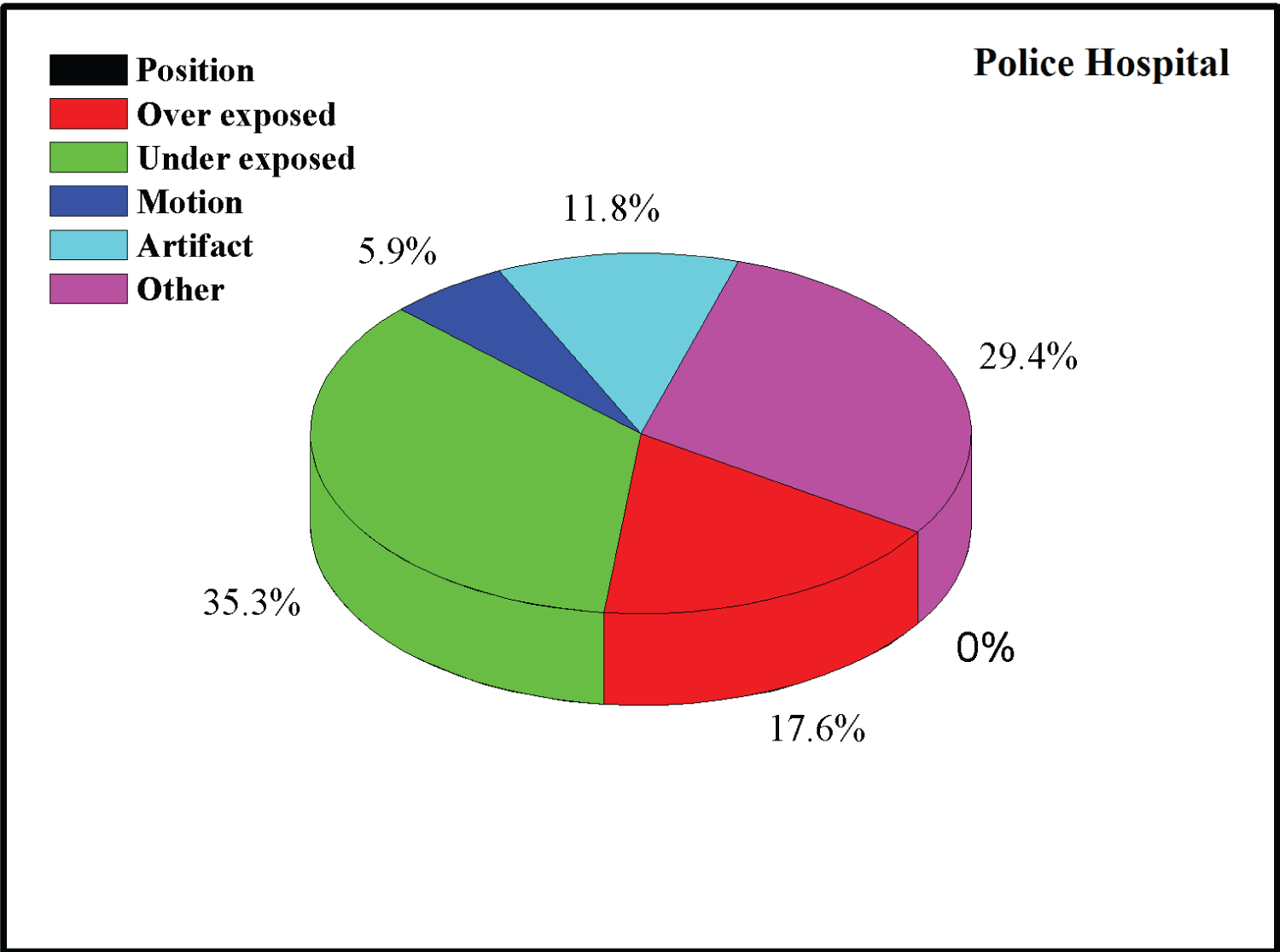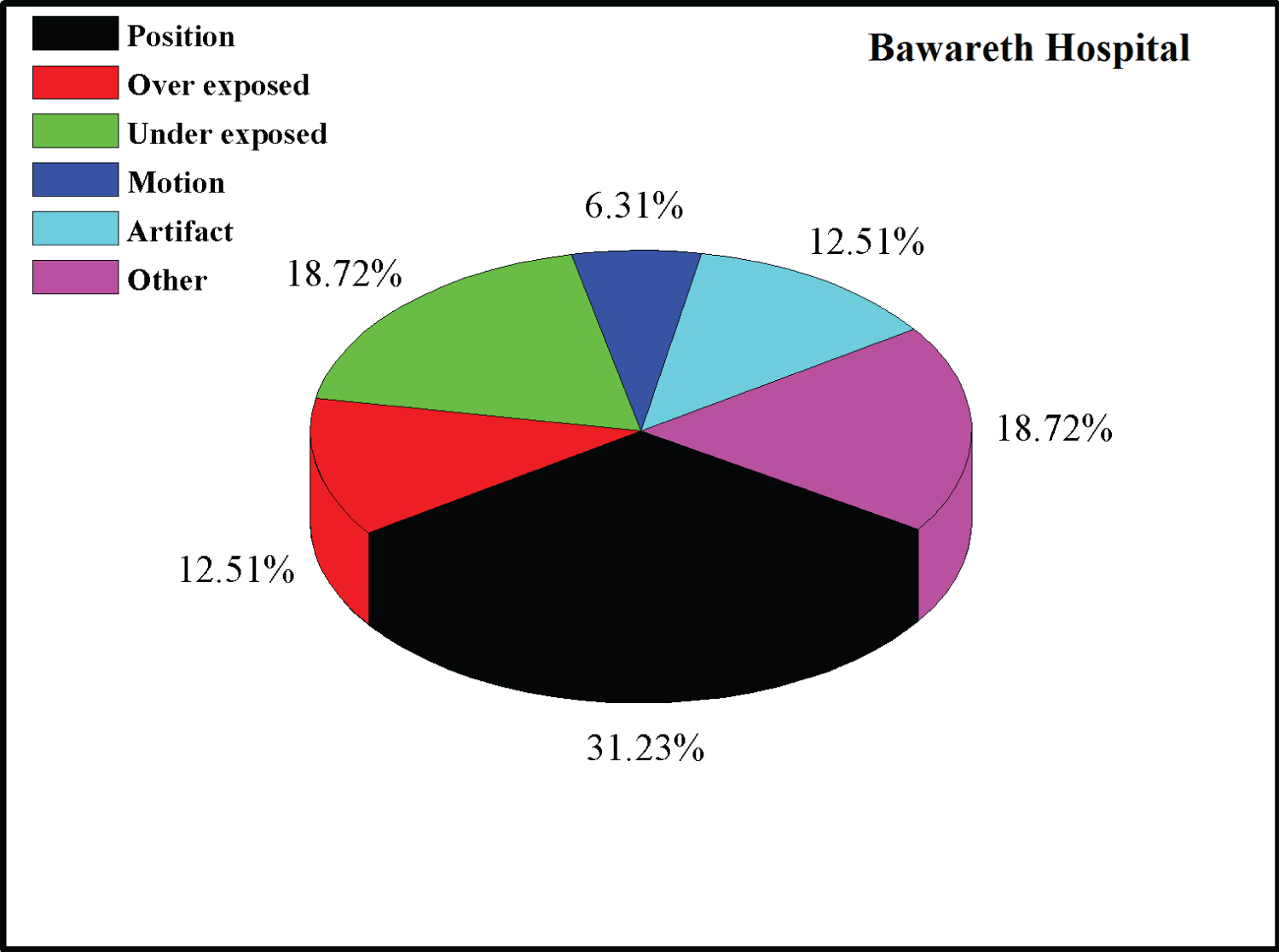Patients normally go through repeated X-ray imaging procedures following the initial imaging exams are rejected because of poor image quality. Repeated images of radiological examinations increase the risk of radiation exposure of the patients, wastes medical resource, and reduce the quality of services of radiology department.
The aim of this study is to perform X-ray film reject analysis in radiology departments of Port Sudan hospitals. The highest reject and repeat rate was found to be chest X-rays whereas, the major factors contributing to film rejection were found to be position and under exposure.
The differences in reject rates and the high reject rate for some exams show that reject analysis is an important quality assurance tool in radiology department. Future reject analysis needs to be performed regularly including an exposure indicator investigation as well as retrospective study of individual rejected images.
X-ray, Reject analysis, Radiology department, Port Sudan
Diagnostic imaging using X-rays represent the common examinations in medicine, account for the most remarkable artificial source of radiation exposure to the population [1]. The two major methods for restricting the radiation doses to patients in medical imaging are to avoid unneeded examinations as well as to make sure the doses from examinations are no larger than required. In addition, the objective of a radiological examination should be to create images of sufficient quality for the clinical task, not images of unnecessarily high quality if that raise the radiation dose to the patient. However, using too low a dose can also be detrimental, if it ends in images that cause a clinical error or needs to be repeated [2].
Repeat or retake analysis is an essential aspect of a quality management program. It is organized process of categorizing rejected images and find out the nature of the repeated images to minimize or eliminate them in the future. Using repeat analysis, we can obtain important data about equipment and accessory performance, departmental procedures, and the experience level of the technical staff. With this procedure, solutions can be found to reduce repeats and report the efficiency or lack of quality control and quality assurance protocols. Furthermore, radiology departments that have converted to digital imaging can benefit significantly by utilizing a repeat analysis program [3].
A rejected image is a radiograph that is considered inappropriate regarding image quality, by the radiologic technologist directly after acquisition [4,5]. Furthermore, as the rejected images increases, department efficiency and patient satisfaction decreases [6]. It is ordinary to come across patients receive some repeated X-ray radiographs following the first X-ray radiographs are rejected because of poor image quality, therefore subjecting patients to additional cost and radiation exposure. Hence, it is necessary to investigate the causes of film reject and repeat in radiology department. Using reject analysis, we can obtain information that would allow us to accomplish efficient reduction in additional cost and minimize the radiation exposure of patients. In this context, reject analysis has therefore emerge as a considerable quality control tool in radiology department [7].
There are very few studies that have examined the reject/repeat rate analysis in radiology departments in Sudan. Nada, et al. studied the film repeat causes and reasons for reject films which identified, and the corrective actions were accordingly applied [1]. The authors reported that, 16.64% and 16.11% of the repeat rate was due to radiographic and processor factors, respectively. In addition, Mohammed, et al. reported the film reject analysis for conventional radiography In Khartoum hospitals and found that, the major reasons for rejection of films were over- or under-exposure and patient positioning [8].
The aim of this study is to evaluate the repeat or reject rate of X-ray films so as to achieve details for further suggestions on cost and patients radiation doses in radiology departments of a selected hospitals in Port Sudan - Sudan. The findings showed in this study can be utilized by the radiology department to point out drawback areas, investigate the causes for such problems and discover methods of correct them.
To the best of our knowledge, this is the first report investigating X-ray film reject/repeat rate in Port Sudan Hospitals.
This study was conducted in the four major hospitals in Port Sudan namely: (Port Sudan Teaching Hospital (PTH), Sea Ports Corporation Hospital (SCH), Police Hospital (PH) and Bawareth Hospital (BAH).
Reject rate is described as the number of films rejected from a particular department and indicated as a percentage of the overall film utilized:
Whereas repeat rate; represent the percentage of clinical X-ray images that must be retaken because of fault leading to inappropriate quality of image [9]:
In each radiology department X-ray films were evaluated by the radiographer, who classified films seen into accepted or rejected. All rejected and repeated films were grouped into seven; based on the cause for rejection. These are:
1. Over exposure
2. Under exposure
3. Patient motion
4. Patient positioning
5. Selection of technique factors
6. Artifact and
7. Others
The statistical analysis of this study was performed using Origin 8.0 software. Categorical variables are tabulated and expressed as percentages and continuous variables as means.
The main advantages of reject/repeat rate analysis are enhanced department skills, lower department costs, and lower patient doses. As the number of repeats remain low, the proportion of time which patients should go through undertaking imaging procedures declines. This will result in patient contentment and the radiology department will be able to diagnose additional patients at the same time. Furthermore, when repeated imaging procedure is minimized, the cost related to film, processing, work of staff, as well as the depreciation of the X-ray machines decreases remarkably [3].
Figure 1 shows the repeat rate by exam type in PTH. As can be seen in Figure 1, the reasons for image rejection are position (10.5%), over exposure (21%), motion (5.2%), artifacts (26.3%) and other (36.8%).
 Figure 1: X-Ray films repeat rate in Port Sudan Teaching Hospital (PTH).
View Figure 1
Figure 1: X-Ray films repeat rate in Port Sudan Teaching Hospital (PTH).
View Figure 1
Results of the repeat rate by exam for SCH are presented in Figure 2 (position 36.36%, over exposure 27.27%, under exposure 27.27% and motion 9.09%). It is clear that imaging procedures due to position error represents the highest cause of repeat rate in SCH. The positioning errors beside the considerable inequality in radiographer reject rates suggest that the standards of image quality in the radiology department may not be harmonious [5,7,10].
 Figure 2: X-Ray films repeat rate in Sea Ports Corporation Hospital (SCH).
View Figure 2
Figure 2: X-Ray films repeat rate in Sea Ports Corporation Hospital (SCH).
View Figure 2
The position error as a cause for reject which reported in PH is (0%), Figure 3. However, the same hospital showed 35.3% reject X-ray imaging procedures due to under exposure. The other causes for rejected films in PH are over exposure 17.6%, artifact 11.8%, motion 5.9% and other 29.4%. Chih-Shenget, et al. proposed five guidelines for training less-experienced imaging technologists to rectify patient position and for displaying notes at suitable sites in the changing room to ask patients to take out artifacts or in the X-Ray imaging rooms notifying technologists to examine machine condition, to take out patients’ artifacts, and to adjust patients’ position prior to examinations [11].
 Figure 3: X-Ray films repeat rate in Police Hospital (PH).
View Figure 3
Figure 3: X-Ray films repeat rate in Police Hospital (PH).
View Figure 3
Figure 4 shows the reject rate in BH. From this figure we can observe that, positioning errors (31.23%) represents the highest cause of repeated imaging procedures followed by under exposure (18.72%), over exposure (12.51%), artifacts (12.51%) and motion (6.31%). Previous studies showed that major hospitals have a less repeated X-Ray imaging procedures compared to small hospitals. This is primarily because radiology departments in major hospitals have excessive number of patients and everyday imaging procedure that lead to enhanced skills of radiography technologists [12]. Furthermore, large hospitals draw extremely certified imaging technologists which are expected to improve the skills of the other technologists working at the same imaging department [12].
 Figure 4: X-Ray films repeat rate in Bawareth Hospital (BH).
View Figure 4
Figure 4: X-Ray films repeat rate in Bawareth Hospital (BH).
View Figure 4
From Table 1 we can observe that, the highest reject and repeat rate was found to be chest X-rays. The most frequent reason for rejection and repetition of patient exams was found to be patient positioning and overexposure due to improper selection of technique factors.
Table 1: Distribution of reject by various examination type in studied hospitals. View Table 1
The study has shown that, the highest reject rate was for chest exams and the most frequent causes for reject are position and under exposure.
Quality image of X-rays are found to be related to quality control measures, perfect selection of exposure factors during radiography and patient position. Hence, it is recommended that, investigation of the rejected films should be carried out regularly as part of the overall quality assurance program of the hospital in order to determine the significance of the problem and also to discover the causes.